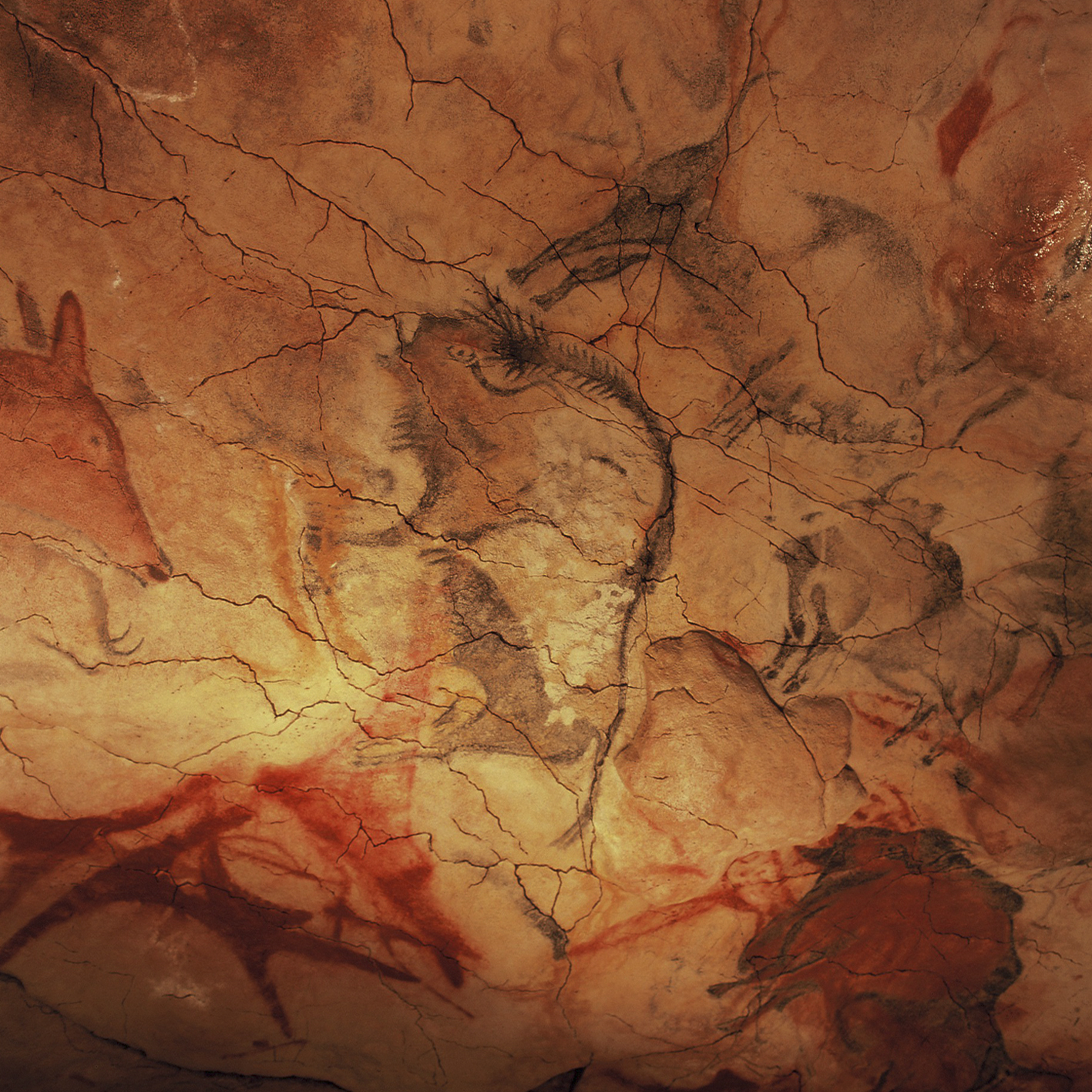Early Man

Paleolithic Art in the Altamira Cave, Spain. Yvon Fruneau & UNESCO (CC by 3.0)
Since the dawn of time humans have found a range of stories to explain how humanity came to be. Each civilization had their own origin story and many of them were quite inventive. It was only within the last few centuries that we devised scientific fields which would give us an evidence-based option for those who value this line of thinking over that of faith-based origin stories. While each of you get to choose your own path when it comes to this topic, it is the belief of many modern scientists that it would be good to understand the evidence-based version of the beginning of man. The intent of explaining this is to understand other options and not to get involved in your choice on the matter.
Nearly all current scientists accept the evidence that leads scholars to believe that the world is about 4.5 billion years old. The history of our planet includes the rise and disappearance of multiple species, including a huge variety of human-like ancestors of ours that are commonly referred to as archaic humans. The concept of species is determined by which groups can, and do, mate with each other. Sometimes these species can split apart, which often leads these groups to evolve on separate paths and, over time, become different than the other group. An
interesting current example of this process are horses and donkeys. The split between the two groups is close enough that they can mate with each other, but distant enough that the offspring of this encounter will be sterile (a group we refer to as Mules). These changes among species most often are the result of trying to adapt to an environment that is different than the one that they previously lived in. We now know, through archeological records, that cats and lions separated into distinct groups around 25 million years ago. Modern day humans are thought to have split from chimpanzees (although we are also close with gorillas and the orangutang) due to both the skeletal remains of archaic humans and DNA testing, which shows only a 1.6% difference between humans and chimpanzees.
Archaeologists have developed this theory due to the discovery of remains within the last few centuries and it has become the norm in scientific communities who have yet to find any solid evidence to refute the argument. Most of the oldest bones found have been uncovered in East Africa (Tanzania, Ethiopia, & Kenya), which is one of many reasons why they are convinced that this was the location where humans first developed. The Olduvai George in Tanzania and Hadar Ethiopia are the two most fruitful places on earth to find the remains of archaic humans, but we are finding remains in other locations also. The most famous of these discoveries was the uncovering of the 3.2-million-year-old female nicknamed Lucy in Ethiopia in 1974. Finding a skeleton of that age with nearly 40% of the bones able to be recovered was a huge victory for archaeologist. Lucy, named after a popular Beatles song of the era, was only about 3 feet tall and gave us a great deal to consider about how humans have developed over that time. She joined the famous remains of Peking Man, a 600,000-year-old set of remains found in China (1926), and Java Man, 350,000-year-old remains found in Indonesia (1891), as the few skeletal remains that are known in popular culture.
While there were tons of species of archaic humans that came and went throughout history, there are some who important in the evolution of modern humans. Australopithecus (southern ape) was the last species before the break to the genus Homo, which is our current genus. These ancestors lived from 4.2 to 1.9 million years ago and were the 1st to make tools. Like the initial decision to leave the trees, this step was instrumental in the development of our hands. The dexterity that it takes to wield tools was so nuanced compared to swinging in trees that it caused a major shift in our hands themselves. Our fingers would shorten, and our joints would change over time to adapt to the use of these new tools. These ancestors walked upright, at least some of the time, and had some very basic form of communication that they used. The development of Homo
Cave art is WAY more advanced and thought out than most realize. Check out a virtual tour of Lascaux Cave in France.
Erectus (upright man) would have lasting effects on the species since they were the first to both walk upright full time. This species, which lived from about 2 million years ago until around 110,000 years ago, completed the break with our tree-living ancestors and developed into the explorers of the day. They were the first to leave Africa and start the process of spreading around the globe. It is estimated that these archaic humans, who looked just like you and I, reached a total worldwide population of 1.5 million people shortly before they died out.
It is important for students to remember that hominids (name for our ancestral tree) went through millions of years of changes since our split with our ape cousins. It may not be fun to think about being related to such animals, but the changes we have made since then have made us what we are today. We are an unusually aggressive species compared to our scientific cousins, although there is mounting evidence of wars among chimp societies also. The ability to speak is, to some, the biggest change among the groups though. Archeologists estimate this skill was fully developed around 200,000 years ago and was a huge jump from previous forms of communication (probably just grunts). This too can be traced by changes that happened to the body over time, as evidenced in the skeletal remains. Prior to this development, the decision to leave the tree was the most striking change in hominid evolution. The decision to leave the trees was the moment where we started the process of rewriting our brains for current humans. Much like modern babies, the manipulation of objects with your hands is key to the development of the brain. Our hands became more finely tuned as we continued to use them, with many of the small muscles we now have developing because of it.
The decision to leave the trees was not without its downsides though. Our ancestors had developed for millions of years to walk on all fours (like apes), and this was a far more difficult shift than most modern humans realize. The biggest issue revolved around our quite large heads. Carrying this oversized head around has led modern humans to have back and neck problems that are unlikely in our ape cousins. This same problem became a major obstacle for childbirth, however. Walking upright caused our hips to narrow while our heads were growing larger, making childbirth an extremely dangerous act for our ancestors. Natural selection favored women who gave birth earlier, since the skull would be less fully formed at that point. These women overwhelmed the numbers of women who were pregnant longer by simply staying alive, while other women usually died in childbirth. These premature births came with problems though. People are still born before many of our vital systems are ready, which causes humans to be relatively helpless for years after birth (as opposed to most animals who can walk soon after birth). This changed required humans to create more dynamic social networks as a means of helping to raise these helpless children. These social networks would be instrumental in molding new children into the societies that they were born into.




